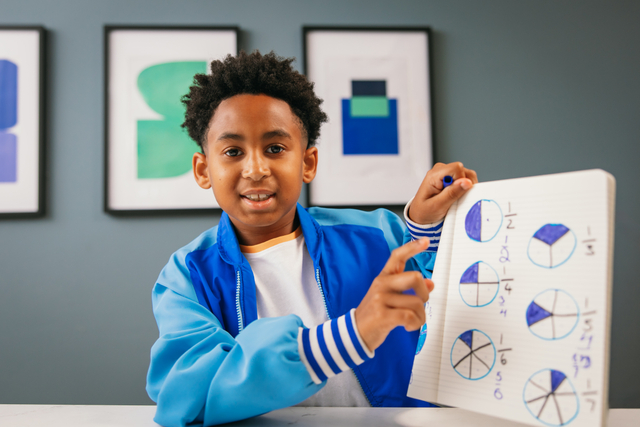1.2.21
Representing Images
Bitmap
Bitmap
Most digital images are stored as bitmaps.


Bitmap
Bitmap
- A bitmap image is split up into tiny squares called pixels.
- The colour of each pixel is stored as a binary number.


Colour-depth
Colour-depth
- The amount of bits used to store the colour of each pixel is known as the colour depth.
- The greater the number of bits used to represent each pixel, the more unique colours can be stored.
- Common colour depths are 1-bit, 8-bit, 16-bit, and 24-bit.


Resolution
Resolution
- Resolution represents the number of pixels in an image.
- The number of pixels is found by multiplying the width by the height of the image.
- An example resolution is 1080p which is 1920x1080.


Metadata
Metadata
- Metadata is extra information that is added to an image file such as:
- The resolution.
- The colour-depth.
- The encoding format.
- The time and date of taking the photo.


File size
File size
- The size (in bits) of an image file is calculated as follows:
- File size (in bits) = image width x image height x colour depth (in bits)
- The size of the image file in bytes is equal to:
- File size (in bytes) = file size (in bits) ÷ 8
Converting Binary and Images
Converting Binary and Images
All images are stored as binary. It's important to be able to convert between an image and its binary representation.


Binary to image
Binary to image
- In a black and white image, each pixel is represented by 1 bit:
- A 0 will represent a black area.
- A 1 will represent a white area.
- The image will be represented by a binary string. Use the value of each bit to colour each pixel in the right colour.
- The binary string starts at the top-left of the image, and represents the first row, followed by the second row, and continues until the end of the image.


Image to binary
Image to binary
- Each pixel of the image will be represented by one bit of the binary string.
- Starting at the top left, and working across the first row:
- Write a 0 if the pixel is black.
- Write a 1 if the pixel is white.
- Continue this process until the end of the image.
1Computer Systems
1.1Systems Architecture
1.2Memory & Storage
1.2.1Types of Memory
1.2.2Flash Memory
1.2.3Virtual Memory
1.2.4Exam-Style Questions - Primary Memory
1.2.5Capacity
1.2.6Solid State Storage
1.2.7Magnetic Storage
1.2.8Examples of Magnetic Storage
1.2.9Optical Storage & its Properties
1.2.10Examples of Optical Storage
1.2.11End of Topic Test - Computer Systems
1.2.12Grade 9 - Storage
1.2.13Exam-Style Questions - Storage
1.2.14Units of Information
1.2.15Number Bases
1.2.16Converting Number Bases
1.2.17Hexadecimal
1.2.18Binary Arithmetic
1.2.19Representing Text
1.2.20ASCII & Unicode
1.2.21Representing Images
1.2.22Representing Sound
1.2.23Data Compression
1.2.24End of Topic Test - Representation
1.2.25Exam-Style Questions -Data Conversions
1.3Computer Networks, Connections & Protocols
1.3.1Benefit of Networks
1.3.2Network Performance
1.3.3Networks: How Do Packets Get Routed?
1.3.4Types of Networks
1.3.5Client-Server Model
1.3.6Pros & Cons of Client-Server Model
1.3.7Peer-to-Peer Model
1.3.8Pros & Cons of Peer-to-Peer Model
1.3.9Network Hardware
1.3.10What is the Internet?
1.3.11URLs
1.3.12DNS & Web Hosting
1.3.13The Cloud
1.3.14Pros & Cons of the Cloud
1.3.15Exam-Style Questions - Networking Models
1.3.16Topology
1.3.17WiFi
1.3.18WiFi Encryption
1.3.19IP Addresses
1.3.20MAC Addresses
1.3.21Network Protocols
1.3.22Application Protocols
1.3.23Layers
1.3.24Advantages of Layering
1.3.25Exam-Style Questions - Network Protocols
1.4Network Security
1.5Systems Software
1.6Ethical, Legal, Cultural & Environmental Concern
1.6.1Open Source vs Proprietary Software
1.6.2Licensing Issues
1.6.3Ethical Issues
1.6.4Ethical Issues 2
1.6.5Exam-Style Questions - Ethical Issues
1.6.6Legal Issues
1.6.7Legal Issues 2
1.6.8Freedom of Information Act (2000)
1.6.9Cultural Issues
1.6.10Environmental Issues
1.6.11Positive Environmental Impact
1.6.12Privacy Issues
1.6.13Stakeholders
1.6.14End of Topic Test - Software & Issues
2Computational Thinking, Algorithms and Programming
2.1Algorithms
2.1.1Computational Thinking
2.1.2Algorithmic Thinking
2.1.3Pseudocode & Flow Diagrams
2.1.4Interpreting & Correcting Algorithm
2.1.5Completing Algorithms
2.1.6Search Algorithms
2.1.7Binary Search
2.1.8Overview of Sort Algorithms
2.1.9Bubble Sort & Insertion Sort
2.1.10Merge Sort
2.1.11Exam-Style Questions - Sorting Algorithms
2.2Programming Fundamentals
2.3Producing Robust Programs
2.4Boolean Logic
Jump to other topics
1Computer Systems
1.1Systems Architecture
1.2Memory & Storage
1.2.1Types of Memory
1.2.2Flash Memory
1.2.3Virtual Memory
1.2.4Exam-Style Questions - Primary Memory
1.2.5Capacity
1.2.6Solid State Storage
1.2.7Magnetic Storage
1.2.8Examples of Magnetic Storage
1.2.9Optical Storage & its Properties
1.2.10Examples of Optical Storage
1.2.11End of Topic Test - Computer Systems
1.2.12Grade 9 - Storage
1.2.13Exam-Style Questions - Storage
1.2.14Units of Information
1.2.15Number Bases
1.2.16Converting Number Bases
1.2.17Hexadecimal
1.2.18Binary Arithmetic
1.2.19Representing Text
1.2.20ASCII & Unicode
1.2.21Representing Images
1.2.22Representing Sound
1.2.23Data Compression
1.2.24End of Topic Test - Representation
1.2.25Exam-Style Questions -Data Conversions
1.3Computer Networks, Connections & Protocols
1.3.1Benefit of Networks
1.3.2Network Performance
1.3.3Networks: How Do Packets Get Routed?
1.3.4Types of Networks
1.3.5Client-Server Model
1.3.6Pros & Cons of Client-Server Model
1.3.7Peer-to-Peer Model
1.3.8Pros & Cons of Peer-to-Peer Model
1.3.9Network Hardware
1.3.10What is the Internet?
1.3.11URLs
1.3.12DNS & Web Hosting
1.3.13The Cloud
1.3.14Pros & Cons of the Cloud
1.3.15Exam-Style Questions - Networking Models
1.3.16Topology
1.3.17WiFi
1.3.18WiFi Encryption
1.3.19IP Addresses
1.3.20MAC Addresses
1.3.21Network Protocols
1.3.22Application Protocols
1.3.23Layers
1.3.24Advantages of Layering
1.3.25Exam-Style Questions - Network Protocols
1.4Network Security
1.5Systems Software
1.6Ethical, Legal, Cultural & Environmental Concern
1.6.1Open Source vs Proprietary Software
1.6.2Licensing Issues
1.6.3Ethical Issues
1.6.4Ethical Issues 2
1.6.5Exam-Style Questions - Ethical Issues
1.6.6Legal Issues
1.6.7Legal Issues 2
1.6.8Freedom of Information Act (2000)
1.6.9Cultural Issues
1.6.10Environmental Issues
1.6.11Positive Environmental Impact
1.6.12Privacy Issues
1.6.13Stakeholders
1.6.14End of Topic Test - Software & Issues
2Computational Thinking, Algorithms and Programming
2.1Algorithms
2.1.1Computational Thinking
2.1.2Algorithmic Thinking
2.1.3Pseudocode & Flow Diagrams
2.1.4Interpreting & Correcting Algorithm
2.1.5Completing Algorithms
2.1.6Search Algorithms
2.1.7Binary Search
2.1.8Overview of Sort Algorithms
2.1.9Bubble Sort & Insertion Sort
2.1.10Merge Sort
2.1.11Exam-Style Questions - Sorting Algorithms
2.2Programming Fundamentals
2.3Producing Robust Programs
2.4Boolean Logic

Unlock your full potential with GoStudent tutoring
Affordable 1:1 tutoring from the comfort of your home
Tutors are matched to your specific learning needs
30+ school subjects covered